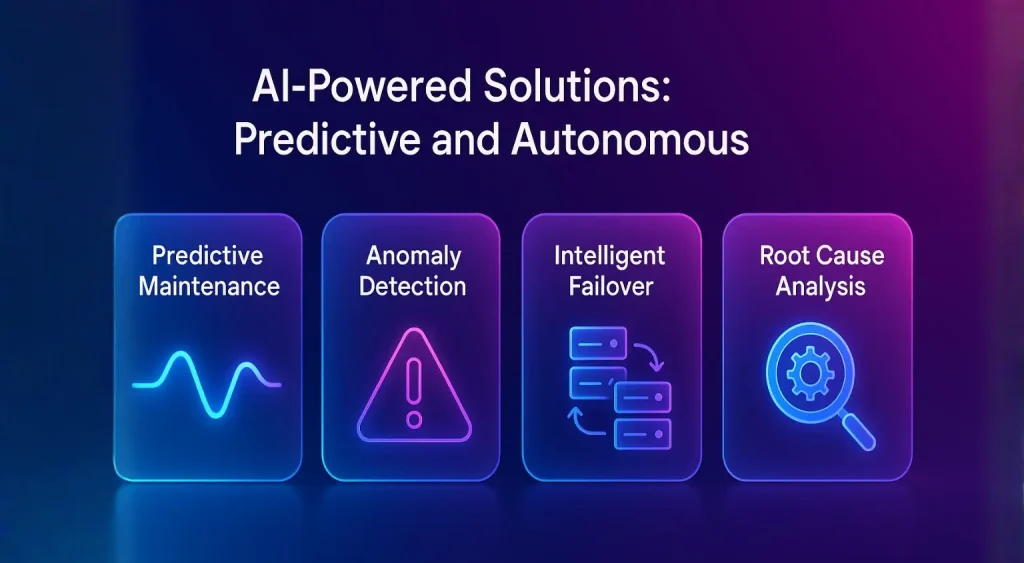- Lifetime Solutions
VPS SSD:
Lifetime Hosting:
- VPS Locations
- Managed Services
- SEO Services
- Support
- WP Plugins
- Concept

Website downtime devastates businesses. Global 2000 companies lose $400 billion annually to downtime, representing 9% of total profits. The average cost escalated to $14,056 per minute for all organizations and $23,750 per minute for large enterprises, marking a 150% increase since 2014. 98% of organizations report that a single hour of downtime costs over $100,000, with 81% facing costs exceeding $300,000 per hour. For Fortune 1000 companies, these figures can reach $1 million per hour. AI-driven monitoring and predictive maintenance fundamentally transform downtime prevention, detecting problems before they cascade into service interruptions.

The greatest effects are on e-commerce and retail. In this sector, Global 2000 companies lose an average of 287 million, 43.5 percent over the industry average, and the large retailers (retailers) lose above 16,000 per minute. The average losses incurred by financial services are 152 million annually, and the costs that financial institutions incur per minute vary between 12,000 and up to 9.3 million an hour. The cost is more expensive and is used in manufacturing at $260,000 per hour, with automotive manufacturers recording the highest rates at 2.3 million per hour.
Financial impact is aggravated by customer abandonment, 25-40% of customers abandon businesses following 3+ hours of downtime, with abandonment rates increasing to 60-75% when there is greater than 6 hours. Also, downtimes hurt SEO ratings. The moderate competition is sufficient to result in a 15 percent decrease in traffic and the loss of almost 15,000 dollars in revenue in 4 hours, and then rebounds after more than 2 months.
Conventional monitoring relies on static alerting rules, pre-set thresholds that trigger regardless of context. This reactive approach means problems are discovered after users experience degradation. Administrators manually review logs, diagnose issues, and implement fixes—consuming hours while downtime compounds.
Predictive Maintenance: Using AI will lower infrastructure failures by 73% as it will constantly monitor and spot the early signs of equipment degradation trends. By means of the detection of the problems in their inception before the development of the serious failures, organizations lose 30-50% of the downtime and 18-25% of the maintenance costs. The accuracy of machine learning models to predict equipment issues is more than 90 percent 30 days prior to them, and predicted uptime and improvements of 10-20 percent via optimized maintenance schedules.
Anomaly Detection: Machine learning algorithms identify unusual patterns that static rules miss, distinguishing between normal context-dependent behavior (like expected traffic spikes during sales) and genuine problems. These systems detect performance anomalies, traffic irregularities, and access pattern deviations that precede outages, enabling proactive intervention. This proactive early-warning capability reduces infrastructure management from reactive to proactive.
Intelligent Failover: Rather than rigid failover rules, AI systems analyze multiple metrics simultaneously, server health, latency, location, capacity, and route traffic optimally in real-time. When failure occurs, AI automatically triggers failover, reducing downtime from hours to seconds or milliseconds.
Root Cause Analysis: AI analyzes metric dependencies and automatically identifies related segments, enabling ops teams to perform root cause analysis in seconds instead of hours. This acceleration means faster problem resolution and minimized impact duration.
Using AI will lower infrastructure failures by 73% as it will constantly monitor and spot the early signs of equipment degradation trends. By means of the detection of the problems in their inception before the development of the serious failures, organizations lose 30-50% of the downtime and 18-25% of the maintenance costs. The accuracy of machine learning models to predict equipment issues is more than 90 percent 30 days prior to them, and predicted uptime and improvements of 10-20 percent via optimized maintenance schedules.
Extended asset lifespan reaches 40% through early degradation detection, while planned maintenance requires 3.2x fewer labor hours than emergency repairs.
Early Problem Detection: Continuous AI monitoring analyzes metrics of the servers, such as disk failures, resource overspending, or security violations, before affecting the user.
Automatic Remediation: When issues are detected, AI can automatically restart services, reallocate resources, or migrate workloads without human intervention, minimizing downtime to seconds.
Predictive Scaling: Machine learning predicts the increase in traffic using past data, advertising, and seasonality and allocates resources anticipatorily before the traffic overwhelms the system.
Intelligent Load Balancing: Rather than static distribution rules, AI adapts load balancing dynamically based on real-time server health, latency, and capacity conditions.
Establish Baselines: Collect comprehensive historical server performance data to establish what “normal” means for your specific infrastructure.
Start Gradual: Begin with anomaly detection on specific metrics (memory, disk), proving value before expanding to complete infrastructure automation.
Choose Appropriate Tools: Choose AI platforms providing predictive analytics, anomaly detection in real-time, and automated alerting with reference to your existing infrastructure.
Continuous Refinement: Regularly update AI models with new data, adjust detection thresholds based on false positive rates, and evolve systems as infrastructure changes.
Establish Response Procedures: Escalate the process of documentation and automate repetitive responses, so that there is a quick response in case anomalies are identified.
The returns of the prevention measures are issued at 174-1,700 per cent, and the payback period may be five months. In context: Datadog is $152-843 per host per month, whereas Dynatrace is thousand per month, but these amounts are insignificant compared to the downtime expenses of an average of $14,056 per minute.
AI can change the scenario of web host failure prevention, where it will be expensive to put out a fire, to a situation where it will be proactive optimization. Organizations can provide the ultra-reliable infrastructure required by modern business by integrating predictive maintenance with a 73 percent reduction in failures and anomaly detection with a 10-millisecond response time (1000 times faster than human response time) and automatic remediation (100 times faster than human response time).